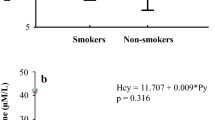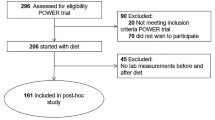Abstract
Background: Elevated plasma concentrations of total homocysteine (tHcy) and obesity are risk factors for cardiovascular disease. The relationship between hyperhomocysteinemia and obesity has not been totally elucidated. Objective: The first aim of the study was to investigate whether anthropometric measurements and insulin resistance contribute to the variation in homocysteine levels in obese adults. Our second aim was to determine if any relationship exists between the carotid intima-media thickness (IMT) and plasma tHcy levels in obese subjects without traditional cardiovascular risk factors. Material and Methods: Fifty-five obese (15 male, 40 female) and 30 (11 male, 19 female) age- and sex-matched apparently healthy volunteers were included. Exclusion criteria were smoking, hypertension, diabetes, vitamin ingestion, hyperlipidemia, renal failure, liver disease, pregnancy, menopause and secondary obesity such as Cushing’s syndrome, hypothyroidism. tHcy, folate, vitamin B12 levels, fasting insulin, glucose, total cholesterol, triglycerides, HDL, LDL particles, uric acid, creatinine and creatinine clearance were measured. Non-invasive ultrasound measurements of carotid IMT were performed. Results: tHcy levels and carotid IMT were comparable between obese and nonobese subjects. Waist/hip ratio (WHR) was related to tHcy and carotid IMT. Hyperhomocysteinemic subjects (tHcy >19.2 μmol/l) had greater WHR than normo-homocysteinemic subjects. Both tHcy levels and carotid IMT were higher in male subjects both in obese and non-obese subjects. No association was observed between insulin resistance and tHcy and carotid IMT. Renal function and abdominal obesity were significant predictors of plasma tHcy levels. Conclusions: We concluded that, in obese subjects who are free from atherosclerosis and impaired renal function, plasma tHcy levels do not differ from healthy subjects. Plasma tHcy concentrations are not related to carotid IMT in obese subjects during the non-atherogenic stage. Although no significant difference was observed between insulin-resistant and insulin-sensitive subjects compared to the plasma tHcy levels, the relationship between tHcy levels and some components of the insulin resistance syndrome may support the opinion that tHcy may be considered a component of the insulin resistance syndrome.
Similar content being viewed by others
References
Jousilahti P, Tuomilehto J, Vartiainen E, Pekkanen J, Puska P. Body weight, cardiovascular risk factors, and coronary mortality. 15-year follow-up of middle-aged men and women in eastern Finland. Circulation 1996, 93: 1372–9.
Boushey CJ, Beresford SA, Omenn GS, Motulsky AG. A quantitative assessment of plasma homocysteine as a risk factor for vascular disease. Probable benefits of increasing folic acid intakes. JAMA 1995, 274: 1049–57.
Ozkan Y, Ozkan E, Simsek B. Plasma total homocysteine and cysteine levels as cardiovascular risk factors in coronary heart disease. Int J Cardiol 2002, 82: 269–77.
Folsom AR. “New” risk factors for atherosclerotic diseases. Exp Gerontol 1999, 34: 483–90.
Wald NJ, Watt HC, Law MR, Weir DG, McPartlin J, Scott JM. Homocysteine and ischemic heart disease: results of a prospective study with implications regarding prevention. Arch Intern Med 1998, 158: 862–7.
Welch GN, Loscalzo J. Homocysteine and atherothrombosis. N Engl J Med 1998, 338: 1042–50.
van Guldener C, Nanayakkara PW, Stehouwer CD. Homocysteine and blood pressure. Curr Hypertens Rep 2003, 5: 26–31.
Splaver A, Lamas GA, Hennekens CH. Homocysteine and cardiovascular disease: biological mechanisms, observational epidemiology, and the need for randomized trials. Am Heart J 2004, 148: 34–40.
van Guldener C, Stehouwer CD. Hyperhomocysteinemia, vascular pathology, and endothelial dysfunction. Semin Thromb Hemost 2000, 26: 281–9.
Fonseca VA, Fink LM, Kern PA. Insulin sensitivity and plasma homocysteine concentrations in non-diabetic obese and normal weight subjects. Atherosclerosis 2003, 167: 105–9.
Konukoglu D, Serin O, Ercan M, Turhan MS. Plasma homocysteine levels in obese and non-obese subjects with or without hypertension; its relationship with oxidative stress and copper. Clin Biochem 2003, 36: 405–8.
El-Khairy L, Ueland PM, Nygard O, Refsum H, Vollset SE. Lifestyle and cardiovascular disease risk factors as determinants of total cysteine in plasma: the Hordaland Homocysteine Study. Am J Clin Nutr 1999, 70: 1016–24.
Marchesini G, Manini R, Bianchi G, et al. Homocysteine and psychological traits: a study in obesity. Nutrition 2002, 18: 403–7.
O’Leary DH, Polak JF, Kronmal RA, Manolio TA, Burke GL, Wolfson SK Jr. Carotid-artery intima and media thickness as a risk factor for myocardial infarction and stroke in older adults. Cardiovascular Health Study Collaborative Research Group. N Engl J Med 1999, 340: 14–22.
Bots ML, Hoes AW, Koudstaal PJ, Hofman A, Grobbee DE. Common carotid intima-media thickness and risk of stroke and myocardial infarction: the Rotterdam Study. Circulation 1997, 96: 1432–7.
Chambers JC, Obeid OA, Refsum H, et al. Plasma homocysteine concentrations and risk of coronary heart disease in UK Indian Asian and European men. Lancet 2000, 355: 523–7.
World Health Organization. Obesity. Preventing and managing the global epidemic. Report of a WHO consultation on obesity. Geneva, 3–5 June 1997. Geneva: World Health Organization 1998.
Friedewald WT, Levy RI, Fredrickson DS. Estimation of the concentration of low-density lipoprotein cholesterol in plasma, without use of the preparative ultracentrifuge. Clinical Chemistry 1972, 18: 499–502.
Matthews DR, Connolly AA, Holman RR, Turner RC. Physiology of insulin secretion: problems of quantity and timing. Neth J Med 1985, 28 (Suppl 1): 20–4.
The Expert Committee on the Diagnosis and Classification of Diabetes Mellitus. Report of the Expert Comittee on the Diagnosis and Classification of Diabetes Mellitus. Diabetes Care 1997, 20: 1183–97.
Riley WA, Barnes RW, Applegate WB, et al. Reproducibility of noninvasive ultrasonic measurement of carotid atherosclerosis. The Asymptomatic Carotid Artery Plaque Study. Stroke 1992, 23: 1062–8.
Gokcel A, Baltali M, Tarim E, et al. Detection of insulin resistance in Turkish adults: a hospital-based study. Diabetes Obes Metab 2003, 5: 126–30.
Jacques PF, Bostom AG, Wilson PW, Rich S, Rosenberg IH, Selhub J. Determinants of plasma total homocysteine concentration in the Framingham Offspring cohort. Am J Clin Nutr 2001, 73: 613–21.
Panagiotakos DB, Pitsavos C, Zeimbekis A, Chrysohoou C, Stefanadis C. The association between lifestyle-related factors and plasma homocysteine levels in healthy individuals from the ATTICA Study. Int J Cardiol 2005, 98: 471–7.
Gomez-Ambrosi J, Salvador J, Paramo JA, et al. Involvement of leptin in the association between percentage of body fat and cardiovascular risk factors. Clin Biochem 2002, 35: 315–20.
Reitman A, Friedrich I, Ben-Amotz A, Levy Y. Low plasma antioxidants and normal plasma B vitamins and homocysteine in patients with severe obesity. Isr Med Assoc J 2002, 4: 590–3.
Nurk E, Tell GS, Vollset SE, et al. Changes in lifestyle and plasma total homocysteine: the Hordaland Homocysteine Study. Am J Clin Nutr 2004, 79: 812–9.
Sanchez-Margalet V, Valle M, Ruz FJ, Gascon F, Mateo J, Goberna R. Elevated plasma total homocysteine levels in hyperinsulinemic obese subjects. J Nutr Biochem 2002, 13: 75–9.
Giltay EJ, Hoogeveen EK, Elbers JM, Gooren LJ, Asscheman H, Stehouwer CD. Insulin resistance is associated with elevated plasma total homocysteine levels in healthy, nonobese subjects. Atherosclerosis 1998, 139: 197–8.
Oron-Herman M, Rosenthal T, Sela BA. Hyperhomocysteinemia as a component of syndrome X. Metabolism 2003, 52: 1491–5.
Godsland IF, Rosankiewicz JR, Proudler AJ, Johnston DG. Plasma total homocysteine concentrations are unrelated to insulin sensitivity and components of the metabolic syndrome in healthy men. J Clin Endocrinol Metab 2001, 86: 719–23.
Abbasi F, Facchini F, Humphreys MH, Reaven GM. Plasma homocysteine concentrations in healthy volunteers are not related to differences in insulin-mediated glucose disposal. Atherosclerosis 1999, 146: 175–8.
Bar-On H, Kidron M, Friedlander Y, et al. Plasma total homocysteine levels in subjects with hyperinsulinemia. J Intern Med 2000, 247: 287–94.
Rosolova H, Simon J, Mayer O Jr, Racek J, Dierze T, Jacobsen DW. Unexpected inverse relationship between insulin resistance and serum homocysteine in healthy subjects. Physiol Res 2002, 51: 93–8.
Ganji V, Kafai MR. Demographic, health, lifestyle, and blood vitamin determinants of serum total homocysteine concentrations in the third National Health and Nutrition Examination Survey, 1988–1994. Am J Clin Nutr 2003, 77: 826–33.
Nygard O, Vollset SE, Refsum H, et al. Total plasma homocysteine and cardiovascular risk profile. The Hordaland Homocysteine Study. JAMA 1995, 274: 1526–33.
Graham IM, Daly LE, Refsum HM, et al. Plasma homocysteine as a risk factor for vascular disease. The European Concerted Action Project. JAMA 1997, 277: 1775–81.
Kazmierski R, Watala C, Lukasik M, Kozubski W. Common carotid artery remodeling studied by sonomorphological criteria. J Neuroimaging 2004, 14: 258–64.
Brattstrom L, Wilcken DE. Homocysteine and cardiovascular disease: cause or effect? Am J Clin Nutr 2000, 72: 315–23.
Author information
Authors and Affiliations
Corresponding author
Rights and permissions
About this article
Cite this article
Uysal, O., Arikan, E. & Cakir, B. Plasma total homocysteine level and its association with carotid intima-media thickness in obesity. J Endocrinol Invest 28, 928–934 (2005). https://doi.org/10.1007/BF03345325
Accepted:
Published:
Issue Date:
DOI: https://doi.org/10.1007/BF03345325




